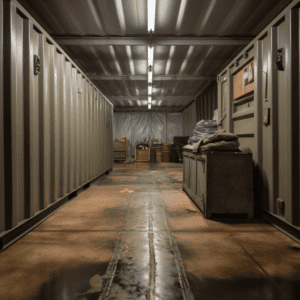Are you struggling to keep moisture out of your storage containers? Moisture can cause damage to your belongings, leading to costly repairs or replacements.
Storage containers are designed to keep your belongings safe and secure, but they aren’t always completely waterproof. Therefore, it’s crucial to implement strategies that will effectively prevent moisture from seeping into the containers.
In this article, we’ll show you how to keep moisture out of your storage containers.
The Importance of Keeping Moisture Out
Take proactive measures to prevent moisture from entering your storage containers to safeguard your belongings. Keeping moisture out of storage containers is of utmost importance.
Moisture can cause damage to your belongings, leading to mold, mildew, and rust. This can result in irreversible damage, reducing the value and functionality of your stored items.
Moisture can also attract pests, such as insects and rodents, which can further damage your belongings. By preventing moisture from entering your storage containers, you can ensure the longevity and preservation of your items.
To prevent moisture, make sure to use moisture-resistant containers, such as plastic bins with tight-fitting lids. Additionally, consider using moisture absorbers, such as desiccants or silica gel packs, to further protect your stored items.
Regularly checking for and addressing any signs of moisture is also crucial in maintaining a moisture-free storage environment.
Why is There Humidity in Shipping Containers
To understand why humidity is present in shipping containers, you need to consider the conditions they’re exposed to during transportation and storage. Shipping containers are often subjected to extreme temperature changes, from hot and humid climates to cold and damp environments. These fluctuations can lead to moisture buildup inside the containers.
Additionally, during transportation, containers may be exposed to rain, snow, or high levels of humidity in the outside air, which can further contribute to the presence of humidity inside. When the warm air inside the container comes into contact with the colder surfaces, such as the walls or ceiling, condensation occurs, increasing the humidity levels.
To prevent condensation and reduce humidity in shipping containers, it’s important to properly seal the containers, use desiccants or dehumidifiers, and ensure adequate ventilation to allow for air circulation and moisture control.

The Natural Occurrence of Humidity
If you have ever wondered why there’s always some amount of humidity in enclosed spaces, it’s because moisture is a natural occurrence that can be found even in sealed environments.
The presence of humidity in enclosed spaces is due to the ambient air that contains water vapor. When this air enters a sealed container, it brings along its moisture content.
Over time, this moisture can build up and lead to an increase in humidity within the container’s interior. Factors such as temperature fluctuations and inadequate ventilation can further contribute to the moisture build-up.
It’s important to understand this natural occurrence of humidity in enclosed spaces to effectively address the issue and prevent damage to stored items.
Factors Contributing to Increased Humidity in Containers
To effectively manage the humidity levels inside your storage containers, you should be aware of the various factors that can contribute to increased moisture.
One factor to consider is container sweat, which occurs when there’s a significant difference in temperature between the inside and the outside temperature of the container. This temperature difference can cause condensation to form on the walls and ceiling of the container, leading to increased humidity.
Another factor is ambient moisture, which refers to the amount of moisture present in the surrounding environment. If the ambient moisture is high, it can easily seep into the container and increase humidity levels.
To combat these factors, it’s essential to ensure proper moisture protection by using moisture-resistant materials and sealing the containers tightly.
Additionally, reducing condensation can be achieved by using desiccants or dehumidifiers inside the containers to absorb excess moisture.
Why Does Humidity in Shipping Containers Cause Problems
The humidity in shipping containers can cause problems. It can lead to the growth of mold and mildew, damage to goods, and corrosion of metal surfaces. When there’s high humidity inside a shipping container, it creates a perfect environment for mold and mildew to thrive. This can be a serious health hazard, as mold spores can cause respiratory issues and allergic reactions.
Additionally, the presence of moisture can damage goods stored inside the container, especially sensitive cargo if they’re sensitive to moisture. Moisture can also cause corrosion of metal surfaces, which can weaken the structural integrity of the container and lead to potential safety hazards.
To prevent these issues, it’s important to address shipping container condensation and moisture issues by using proper ventilation and insulation. Regularly inspect and maintain the container walls to ensure they’re watertight.

Shipping Container Condensation Issues
Don’t overlook the potential condensation issues that can arise in shipping containers. Moisture can be a significant problem when it comes to storing goods in these containers.
Shipping containers are often exposed to extreme temperature changes, and this can lead to condensation forming inside. When warm air comes into contact with the cold walls of the container, moisture can accumulate and cause damage to the stored items. This can result in mold growth, rust, and deterioration of products.
To prevent condensation issues, it’s essential to properly seal the container and use moisture-absorbing materials such as desiccants or moisture barriers. Regularly inspecting the container for any signs of moisture buildup and addressing it promptly is crucial to ensure the safety and quality of the goods stored inside.
Container Rain
To prevent container rain from damaging your stored items, it’s important to understand its causes and take necessary precautions.
Container rain, also known as container sweat or cargo sweat, occurs when there’s a significant difference in temperature between the inside and outside of a storage container. When warm, moist air comes into contact with the cool surfaces of the container, condensation forms, leading to moisture buildup. This moisture can then drip onto your stored items, causing damage and mold growth.
The implications of container rain are significant, as it can ruin your belongings, compromise the structural integrity of the container, and lead to costly repairs.
To prevent container rain, it’s crucial to:
– Properly insulate your storage containers
– Use desiccants or moisture absorbers
– Ensure adequate ventilation to minimize the moisture in the air.
Factors Leading to Condensation Inside the Container
To prevent condensation inside the container, it’s important to understand the factors that contribute to its formation.
Moisture can accumulate inside a storage container due to several reasons. One significant factor is the presence of moisture-laden air when the container is sealed. If the air inside the container contains high levels of moisture, it can create condensation when it comes into contact with cooler surfaces.
Another factor is poor airflow within the container. Insufficient ventilation can result in stagnant, humid air, which increases the chances of condensation.
Additionally, temperature fluctuations can play a role. When the ambient temperature inside the container fluctuates, it can cause moisture to condense on the surfaces.
Key Tips
Improve Ventilation
Ensure proper airflow and reduce moisture buildup by installing vents or fans in your storage containers.
Adequate ventilation is crucial in keeping your storage boxes dry and free from moisture damage. When air circulates freely within the container, it helps to prevent the buildup of condensation and allows any excess moisture to evaporate. This is especially important if you’re storing items that are susceptible to damage from moisture, such as clothing, books, or electronics.
By providing sufficient ventilation, you create a healthier environment for your stored belongings and minimize the risk of mold or mildew growth. Consider installing vents on the sides or top of the storage containers to allow air to flow in and out.
Additionally, you can also use fans to improve air circulation within the containers, ensuring that moisture is effectively controlled.
Use Insulation
Have you considered using insulation to prevent moisture from entering your storage containers?
Insulating your containers can be an effective way to keep moisture at bay. By creating a barrier between the outside environment and the contents of your storage containers, insulation can help maintain an airtight seal. This prevents any moisture from seeping in and causing damage to your belongings.
There are various insulation materials available, such as foam boards or spray foam, that can be easily applied to the interior walls of your storage containers. These materials not only provide insulation but also create a moisture-resistant barrier.
Use Dehumidifying Tools
Consider utilizing a dehumidifier to help keep moisture out of your storage containers. Moisture can be a major issue when it comes to storing items, as it can lead to mold, mildew, and damage to your belongings.
By using a dehumidifier, you can effectively reduce the moisture levels in your storage unit and prevent these problems from occurring. Dehumidifiers work by removing excess moisture from the air, creating a drier environment.
This can be especially helpful in areas with high humidity or during the rainy season. Place the dehumidifier in your storage unit and let it run continuously to maintain optimal moisture levels in dry air.
Regularly check and empty the water reservoir to ensure it continues to work effectively. Investing in a dehumidifier is a simple yet effective way to protect your storage containers and keep your belongings safe and dry.
Use Desiccants
To effectively keep moisture out of your storage containers, try using desiccants like silica gel or activated charcoal.
Desiccants are substances that absorb moisture from the air, helping to maintain a dry environment inside the containers. Silica gel, often found in small packets, is a popular desiccant due to its high moisture absorption capacity. It can effectively absorb moisture and prevent mold or mildew growth.
Activated charcoal is another great option that not only absorbs moisture but also helps eliminate odors. These desiccants can be placed inside the storage containers to keep moisture at bay.
Remember to replace or recharge the desiccants regularly to ensure their effectiveness. Using desiccants is a simple and cost-effective way to keep moisture out of your storage containers and protect your belongings from damage.
Frequently Asked Questions
What is the best moisture absorber for a container?
The best moisture absorber for a container is silica gel packets. These packets are food contact safe, made of oil-resistant aiwa paper, and the silica gel beads maintain their dry surface even when saturated with water.
How do you prevent condensation in a sealed container?
To prevent condensation in a sealed container, it’s essential to understand that condensation occurs when the container’s internal temperature drops below the dew point of the air inside, often due to external temperature fluctuations. Ensuring proper ventilation can help equalize internal and external temperatures, reducing condensation risks.
What can I put in my storage container to prevent mold?
To ward off mold in storage containers, ensure all items are clean and thoroughly dry before storage. Incorporate desiccants, such as silica gel packets, within your containers to absorb any lingering moisture, and remember to check and replace them as needed based on expiration dates. Emphasize good airflow by ensuring items aren’t placed directly against walls or on concrete floors, and consider using breathable, acid-free boxes or vacuum-sealed bags for specific items like art, books, or clothing
Conclusion
So remember, keeping moisture out of storage containers is crucial to avoid potential damages.
Whether it’s using dehumidifiers or strategically placing desiccants, taking proactive measures will help protect your stored items.
By understanding the causes of humidity and implementing these solutions, you can ensure that your belongings remain safe and dry in storage.


